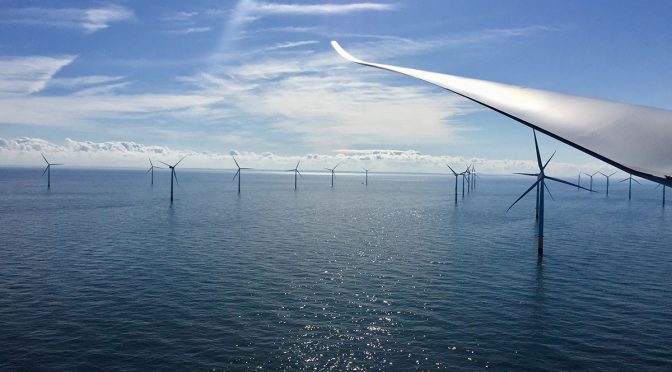Study finds 28 Gigawatts, $1.7 Billion in U.S. Treasury Revenue Achievable by 2022; Delivers $166 Billion in Offshore Wind Power Industry Investment and Supports 80,000 jobs annually by 2035.
The United States has an opportunity to accelerate offshore wind energy growth, and benefit from 28 new gigawatts of clean energy and $1.7 billion in U.S. Treasury revenue by 2022, a new study released today from research group Wood Mackenzie finds.
Findings from this study confirm additional lease areas are needed to meet demand, reduce energy costs, increase competition, and ultimately generate thousands of jobs and billions in investment. Additionally, the findings offer guidance to decision-makers about new offshore wind leases, which can be a short-term solution to jump start recovery from a coronavirus pandemic-driven economic slowdown.
Commissioned by four energy industry groups, American Wind Energy Association (AWEA), National Ocean Industries Association (NOIA), New York Offshore Wind Alliance (NYOWA), and the Special Initiative on Offshore Wind (SIOW) at the University of Delaware, the study dives into the economic impact of offshore wind activities as a result of potential Bureau of Ocean Energy Management (BOEM) lease auctions in 2020, 2021 and 2022. Based on existing activities and policy assumptions for future offshore wind development, two million acres of federal waters in the New York Bight, which includes parts of New Jersey, as well as California and the Carolinas, could be auctioned for commercial leases as early as this year as well as in 2021. Such leasing could support 28 GW of offshore wind development and generate $1.2 billion in U.S. Treasury revenue. Other auctions for lease areas in the Gulf of Maine and areas in California could happen in 2022 and would generate an additional $500 million in U.S. Treasury revenue.
Significant capital investment will be put into the U.S. economy to support offshore wind activities. Total investment in the U.S. offshore wind industry will be $17 billion by 2025, $108 billion by 2030 and $166 billion by 2035. From 2022 to 2035, capital investment of $42 billion will go to turbine manufacturers and the supply chain, $107 billion will go to the construction industry, and $8 billion will go to the transportation industry and ports. Annual capital investment for O&M activities will increase to $2.4 billion in 2035.
In addition to delivering clean energy to millions of households, the offshore wind industry will also contribute a variety of economic benefits to the U.S. economy, including supporting tens of thousands of jobs and billions of dollars in capital investment. If the assumed BOEM auctions in 2021 and 2022 happen, total full time equivalent (FTE) job creation from the resulting offshore wind activities, including development, construction and operation will be approximately 80,000 jobs annually from 2025 to 2035.
American Wind Energy Association
“Policymakers at the Federal and State levels right now hold the key to unlocking the full potential of the offshore wind industry that will benefit all Americans. We’re on the cusp of a rare opportunity, but the U.S. remains far behind other countries in harnessing offshore wind technology. It’s time for us to unleash this abundant domestic energy source that will deliver tens of thousands of new jobs, revitalize coastal ports, and expand manufacturing opportunities, to reap major economic and environmental benefits.” – Laura Morton, AWEA Senior Director of Offshore Wind
National Ocean Industries Association
“American offshore wind is a generational opportunity. Infrastructure spending, energy security, and shovel-ready jobs with good wages will be unleashed. Importantly, offshore wind development will support jobs throughout the entire U.S. The same shipbuilders, heavy lift vessel operators, steel fabricators and countless other companies who built the Gulf of Mexico oil and gas sector stand ready to lend their expertise to the American offshore wind industry.” – Erik Milito, NOIA President
New York Offshore Wind Alliance
“The Wood Mackenzie study provides a new impetus for the designation and leasing of new wind energy areas in federal waters off the U.S. coastline. States along the eastern and western seashores have a massive domestic clean energy resource and many states have set ambitious offshore wind goals to reap the economic and environmental benefits that offshore wind offers but cannot achieve those goals with existing leases. This study documents the enormous near- and mid-term economic benefits that offshore wind energy can provide: more than $1 billion in revenue to the federal treasury, tens of thousands of jobs and billions in investments in ports, vessels and other infrastructure, at a time when the nation needs it the most. It’s time for the federal government to act with the same urgency as the states.” – Joe Martens, Director, New York Offshore Wind Alliance, A project of ACE NY
Special Initiative on Offshore Wind
“Wood Mackenzie’s new analysis reinforces and proves what offshore wind advocates already know: that offshore wind development can be a major part of the solution to our country’s most pressing energy needs and our country’s most immediate economic woes. Unleashing the potential of offshore wind power through immediate and consistent auctioning of new lease areas can help the United States rebound from the greatest economic downturn in our nation’s history. The Wood Mackenzie study provides the right proof points at the right time: that the swift pivot to auctioning lease areas in the New York Bight, California, the Carolinas and the Gulf of Maine could result in the development of 28 GW of offshore wind energy, 80,000 much-needed American jobs per year by 2035, more than $1 billion to the U.S. Treasury, and $166 billion in total investment in the U.S. economy by 2035. SIOW urges decision-makers in the Department of the Interior and the Bureau of Ocean Energy Management to heed the findings of this new analysis and act quickly to unlock the multi-faceted potential of U.S. offshore wind development.” Nancy Sopko, Executive Director, Special Initiative on Offshore Wind


